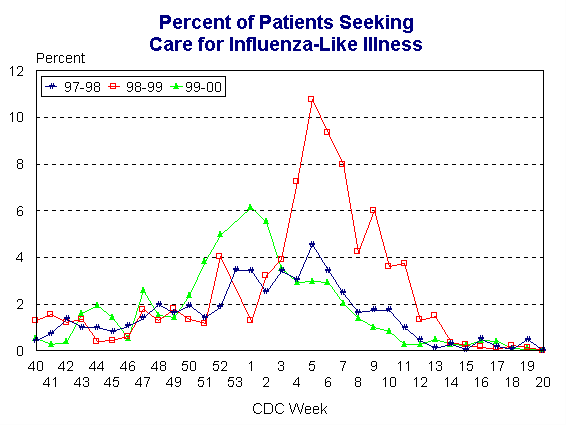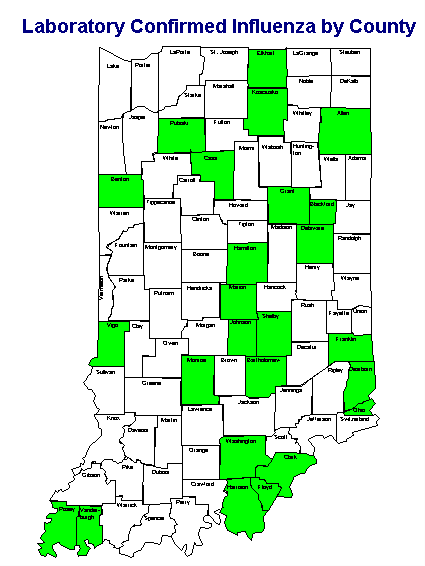
Appendix A
Indiana Influenza Surveillance, 1999-2000
Alan K. Oglesby, MPH
Epidemiology Resource Center
Indiana State Department of Health
Influenza surveillance during the 1999-2000 influenza season was conducted in cooperation with the Centers for Disease Control and Prevention (CDC). Twenty-eight Indiana physicians, nurse-managed clinics, and university student health centers volunteered to be sentinel physicians/sites. Of that number, 25 submitted morbidity reports and 23 submitted nasopharyngeal cultures for virus isolation. Sentinel reporting location and the number by county are provided in Figure 1.
Figure 1.

During each week of the surveillance period, CDC week 9940 (ending Sat. Oct. 9, 1999) to CDC week 0020 (ending Sat., May 20, 2000), sentinel sites tracked the number of patients requesting care for "influenza-like illness" by age groups. "Influenza-like illness" is defined for the purpose of surveillance by CDC as "Fever (> 1000 F. [37.80 C], oral or equivalent) and cough or sore throat (in absence of a known cause)" and the total number of patients seen. Each week, sentinel sites were asked to report these figures to CDC via telephone or facsimile. Participants were also asked to collect nasopharyngeal swabs from patients presenting with "influenza-like illness" whose onset of clinical signs had started within 72 hours and send them to the Indiana State Department of Health (ISDH) Laboratory. The ISDH Laboratory conducted viral isolation and identification by influenza type and subtype.
During the surveillance period, sentinel sites reported seeing 98,206 patients with 1,778 seeking care for "influenza-like illnesses." Figure 2 provides a graphical display of the percent of patients presenting with "influenza-like illness" by the week. The occurrence of "influenza-like illnesses" during the 99-00 period more closely mimicked the 97-98 period as opposed to the 98-99 period, which was more severe and prolonged. For the 99-00 season, the number of patients exceeding 3% peaked on week one, and the percentage of patients with "influenza-like illness" stayed above 3% for six weeks versus the eleven weeks for the 98-99 season.
Figure 2.

It has been CDC's experience that when "influenza-like illness" patients represents less than 3% of patients seen, the cause is primarily respiratory viruses other than influenza, but once the "influenza-like illness" percentage exceeds 3%, influenza viruses dominate. The first positive influenza virus isolation occurred during week 9945. However, the percentage of patients seen with "influenza-like illness" did not exceed 3% until week 9951. Figure 3 presents the results of nasopharyngeal culturing of "influenza-like illness" patients. Unlike the previous influenza season (1998-99), where Influenza B and Influenza A occurred simultaneously throughout the season, the 99-00 season was limited to Influenza A, primarily Type A (H3N2). Typed influenza isolates were the same as those present the 1999 influenza vaccine.
Figure 3.

Influenza A infections were widely distributed across the state. Of the 188 influenza cultures from Indiana that were typeable by the ISDH and WHO/NREVSS Collaborating Laboratories, 108 (57%) were influenza A (unknown), 75 (40%) were influenza A (H3N2), and 5 (3%) were influenza A (H1N1). There was no type B or type C influenza infections identified in 1999-2000. Figure 4 presents the geographic distribution of 24 counties where there were ISDH laboratory confirmed influenza cases. This distribution pattern is biased by the locations of Influenza Surveillance Sentinel Sites.
Figure 4.

Age distribution of patients seeking care for "influenza-like illness" varied somewhat from the previous two seasons (see Figure 5). In 1999-2000, the incidence among the 5-24 year old group was less than 50% for the first time since the sentinel surveillance system began in Indiana. In addition, the incidence among the 25-64 year old group has increased substantially in each of the past two years.
Figure 5.
